The Art & Science of Facial Feature Setting
How does a mortician close the mouth of the deceased? Morticians typically use one of these methods:
- Needle Injector Method - Barbed needles inserted into the maxilla (upper jaw) and mandible (lower jaw) with twisted wires to secure them
- Musculature (Septal) Suture - Thread passed through the nasal septum and tied to the lower jaw
- Sublingual Suture - Stitches placed under the tongue to secure the jaw
- Mouth Formers - Clear vinyl devices placed in the mouth to maintain shape
- Adhesives - Cyanoacrylate (medical-grade superglue) used primarily for infants or special cases
When someone passes away, their facial muscles relax completely, often leaving the mouth open. Setting the features—particularly closing the mouth—is one of the first and most important steps in preparing the deceased for viewing. This process helps create a peaceful, natural appearance that provides comfort to grieving families.
The method chosen depends on several factors: the condition of the jaw, whether the deceased has dentures, any facial trauma, and the timeframe for viewing. Proper mouth closure not only creates a dignified appearance but also prevents fluid leakage during the embalming process.
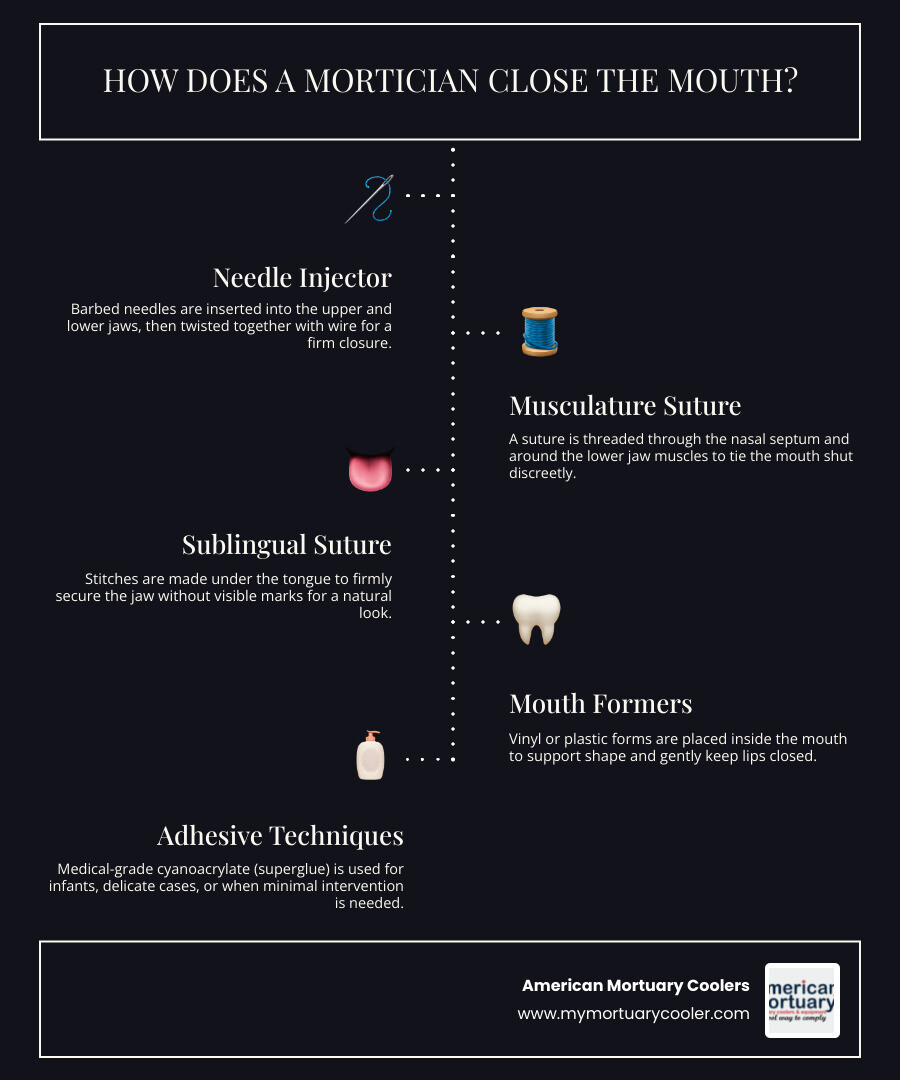
Step 1 – Understand Why & When the Mouth Must Be Closed
When families ask about how does a mortician close the mouth, I always start by explaining why this step matters so much in the preparation process. This isn't just a technical procedure—it's about creating peace and dignity for both the deceased and their loved ones.
The main purpose of closing the mouth is creating that serene, restful appearance we all hope to see when saying goodbye to someone we love. An open mouth can appear jarring during viewings, potentially making an already difficult moment even harder for family and friends.
Beyond the emotional aspects, closing the mouth serves several practical purposes:
Preventing fluid leakage is crucial during and after the embalming process. Without proper closure, embalming fluids or natural bodily fluids might escape through the oral cavity.
Maintaining facial symmetry helps create that natural, peaceful expression. The mouth is central to a person's appearance, and proper positioning contributes significantly to how restful they appear.
Supporting proper embalming happens when the mouth is correctly positioned, allowing embalming fluids to distribute evenly throughout facial tissues.
Timing matters tremendously in this process. We typically close the mouth immediately after initial disinfection but before beginning arterial embalming. This early timing is intentional because:
- Rigor mortis needs addressing first—the natural stiffening of muscles after death can make positioning difficult if not managed early.
- The jaw must be secured before introducing embalming fluids, as these chemicals can change tissue elasticity.
- Early closure helps prevent any purging from the mouth during the embalming process.
Step 2 – Pre-Closure Preparation of the Oral Cavity
Before answering the question of how does a mortician close the mouth, there's important preparatory work that must be done to ensure a successful closure and natural appearance.
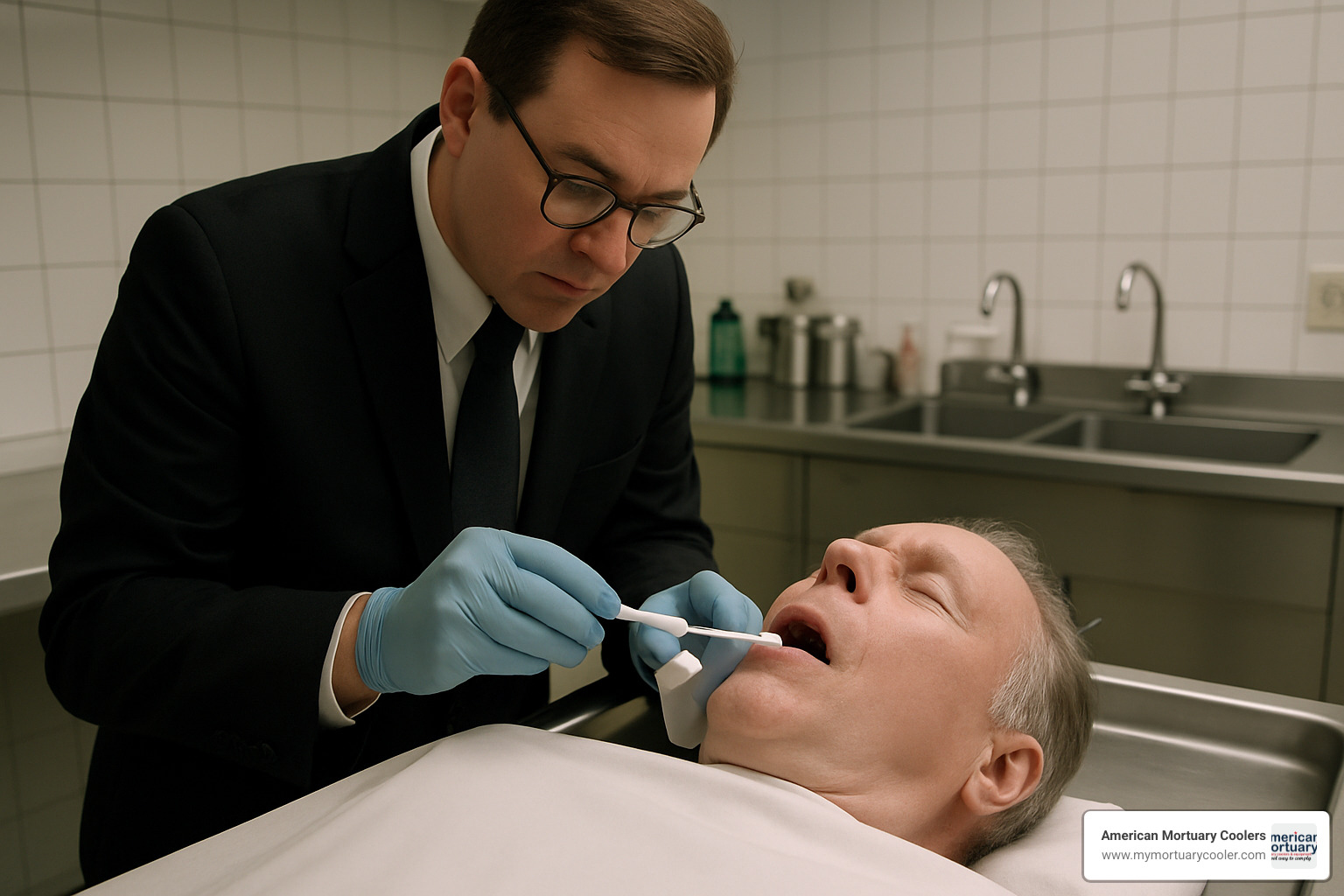
Think of the oral cavity preparation as laying the foundation for a house – if it's not done properly, everything built on top will be unstable.
First, we begin with a thorough disinfection of the mouth and throat using gentle antimicrobial swabs – not just for sanitation, but out of respect for the deceased.
Next comes aspiration, where we remove any fluid that may have accumulated. Using specialized suction tools, we ensure the oral cavity is clear, preventing any unexpected fluid release during the viewing.
The throat packing step is crucial. We gently place cotton or gauze deep in the throat, creating a barrier that prevents embalming fluids from entering the mouth.
Proper tongue positioning significantly impacts how natural the deceased appears. The tongue needs to lie flat and in a relaxed position. Sometimes, if the tongue doesn't cooperate, we'll place a small, hidden suture to keep it properly positioned.
When it comes to dentures, we handle them with special care. If the family provides them, we clean them thoroughly before placement. If they're already in place, we ensure they're secure and positioned naturally.
To prevent the drying of tissues, we apply moisture cream to the lips and inside of the mouth. This specialized product helps maintain a lifelike appearance and prevents cracking or shrinking.
For cases where the deceased doesn't have dentures or has missing teeth, we use Webril cotton strips soaked in moisturizing solution to provide structure to the lips and cheeks.
More info about embalming supplies
How Does a Mortician Close the Mouth? Choosing the Right Technique
When families ask how does a mortician close the mouth of their loved one, I explain that there's no one-size-fits-all approach. Skilled morticians choose different techniques based on the unique needs of each person in their care.
The mortician considers several important factors: Is the jaw bone strong or fragile? Does the person have natural teeth or dentures? Was there any facial trauma? How old was the person? Are there religious preferences to respect? And how long will the viewing period be?
Let me walk you through the main approaches used today:
| Technique | Best For | Advantages | Disadvantages |
|---|---|---|---|
| Needle Injector | Most adult cases | Fast, secure, adjustable | Invasive, requires bone integrity |
| Musculature (Septal) Suture | Elderly, denture wearers | Works with atrophied bone, adjustable | More time-consuming, requires skill |
| Sublingual Suture | Trauma cases, fractured jaws | Less visible externally | Complex, difficult in decomposition |
| Mouth Formers | Denture wearers, edentulous | Non-invasive, shapes lips | May not be secure enough alone |
| Adhesives | Infants, minimal intervention cases | Non-invasive, quick | Less secure, limited adjustability |
Needle Injector: The Classic Answer to "How Does a Mortician Close the Mouth?"
The needle injector method is the most common technique used across America today. It's quick, reliable, and effective for most adults.
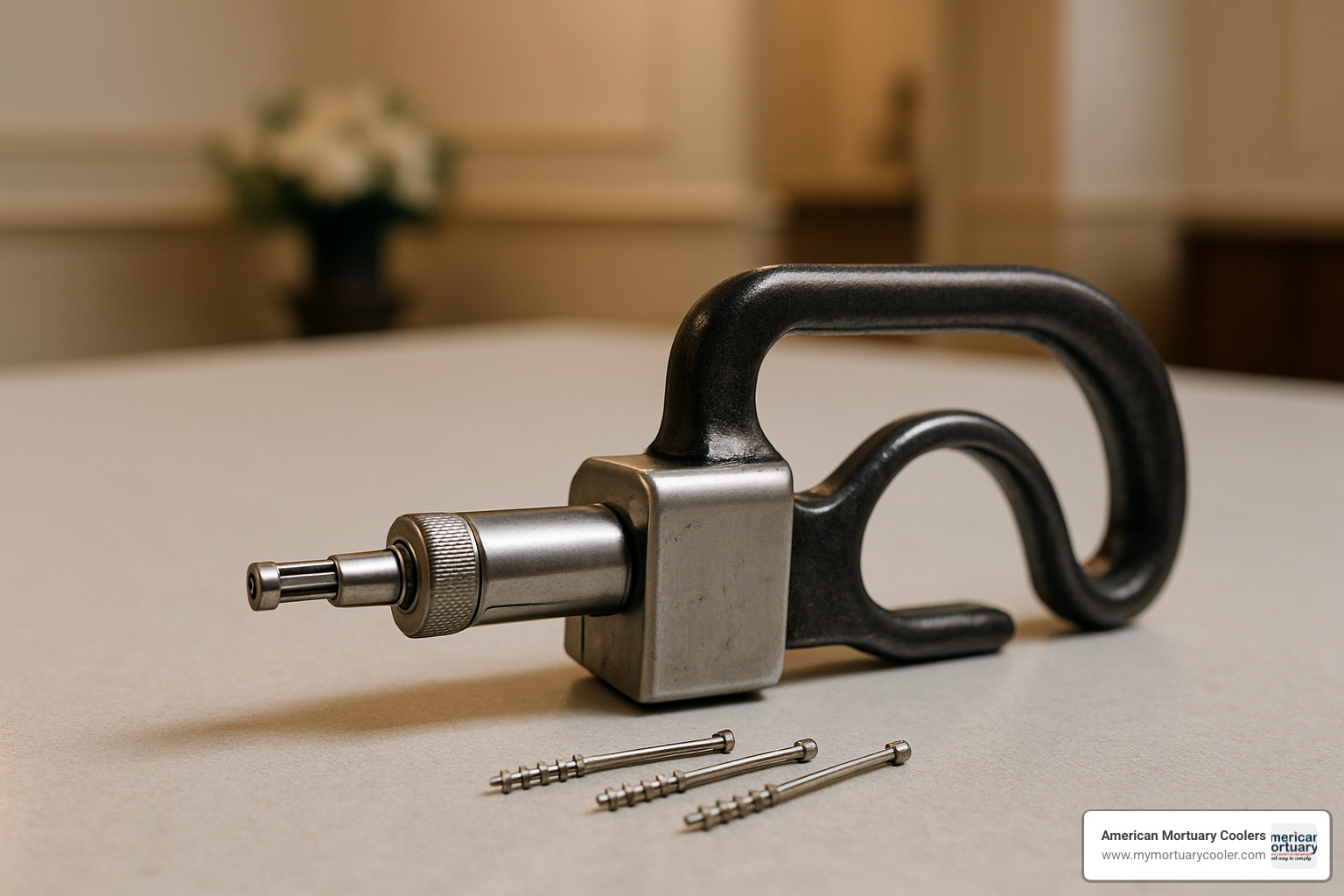
The mortician first gently positions the jaw to create a natural expression. Then they use the injector, which has two barbed needles connected by a wire. The first needle goes into the upper jaw (maxilla), angling upward toward the nasal cavity. The second needle is placed in the lower jaw (mandible), directed downward to get good bone purchase.
Once both needles are placed, the mortician carefully twists the connecting wire, drawing the jaws together until they achieve that natural closed position. The twisted wire is then secured.
Step-by-Step Guide to Needle Injector Embalming
Muscle/Septal Suture: Another Way a Mortician Closes the Mouth
When the needle injector isn't the right choice – often for elderly people with bone loss, denture wearers, or those with facial trauma – the septal suture technique offers an excellent alternative.
The mortician prepares a strong silk suture with a curved needle. They carefully pass this needle through the nasal septum (the cartilage between your nostrils) and then through the muscle tissue under the chin or into the lower jaw itself.
What makes this technique special is the temporary bow tie the mortician creates. Rather than making a permanent knot right away, they tie the suture in a bow that can be adjusted after embalming is complete.
Non-Invasive & Infant Techniques
Sometimes, answering how does a mortician close the mouth calls for gentler approaches, especially when caring for infants, honoring religious traditions, or preparing for brief viewings.
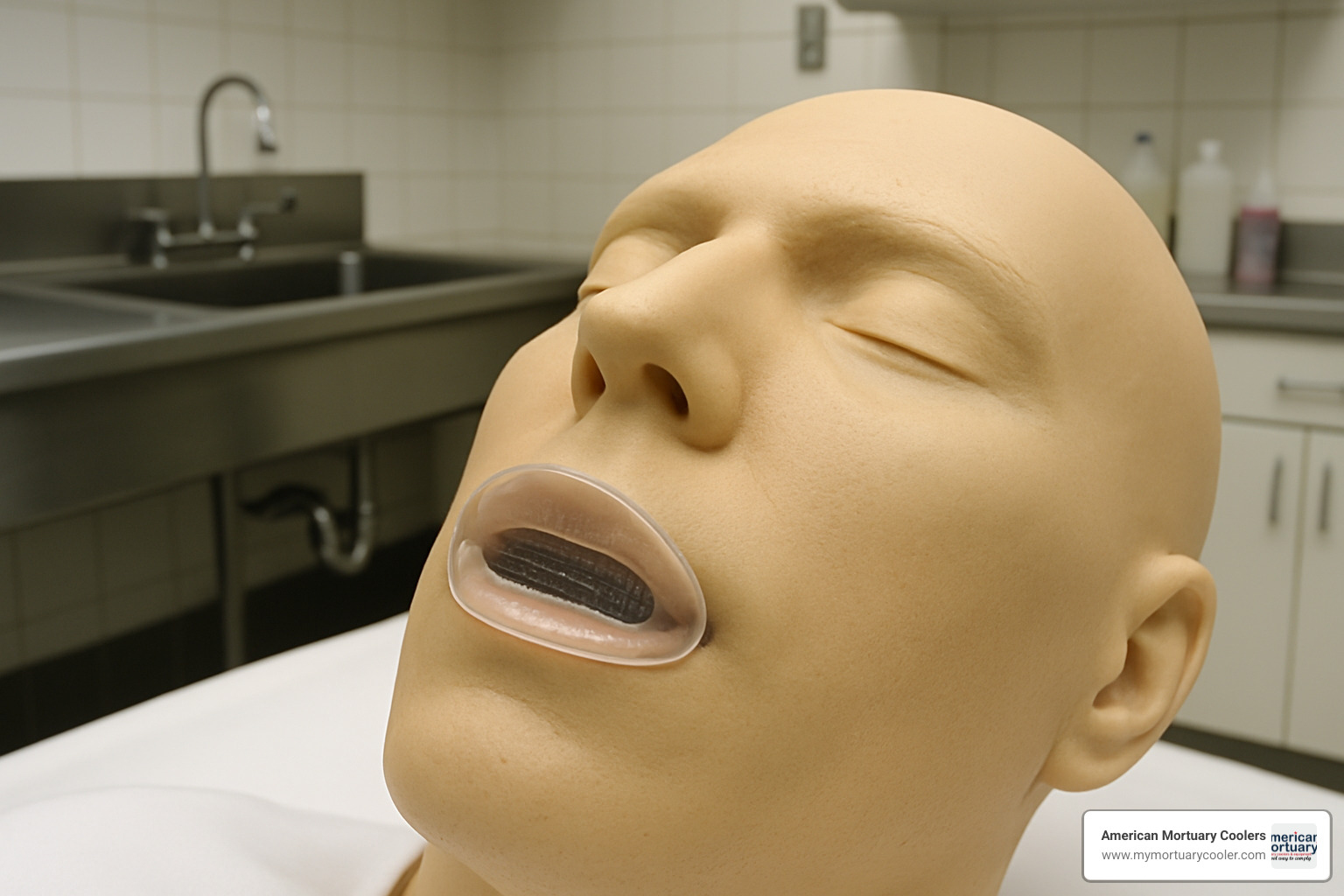
Mouth formers are clear vinyl devices that slip between the gums or dentures to help create a natural expression from within. They're particularly useful when dentures are missing or when the person had no teeth.
For simpler cases, the cotton roll technique offers neat simplicity. The mortician places cotton rolls between the gums or denture ridges and temporarily secures the jaw with a gauze bandage wrapped under the chin and over the top of the head.
For infants, medical-grade cyanoacrylate (essentially a specialized superglue) provides a gentle solution. A small amount is applied to the inside of the lips, which are then pressed together until the adhesive sets.
Step 4 – Finishing Touches for a Natural Resting Expression
After successfully answering the question of how does a mortician close the mouth, the focus shifts to creating a truly peaceful, natural-looking expression. This is where art meets science in mortuary care – changing a technically closed mouth into one that appears restful and lifelike.
Lip Alignment and Shaping is our first priority. Using dental floss, we gently manipulate the lower lip to create a natural width – not too tight which would create tension lines, and not too loose which might appear unnatural. Many morticians develop their own techniques for this delicate work, often using their fingers to massage the lips into a natural position.
Once basic alignment is achieved, we move to Filling and Contouring. Aging, illness, or post-mortem changes can cause lips to appear sunken, so we use colored restoration wax to restore natural fullness. This is particularly important when dentures are missing – we'll build up the mouth area using cotton or wax to maintain natural facial contours.
Moisture management is crucial for maintaining appearance throughout viewing. We apply Sealing and Moisturizing products like petroleum jelly to prevent drying and add a natural sheen. Specialized mortuary cosmetics match the deceased's natural skin tone.
Before considering our work complete, we always perform a Final Assessment from multiple angles. We step back, checking for any tension lines and ensuring symmetry and balance in the facial features.
Step 5 – Troubleshooting, Special Cases & Cultural Considerations
Even with expertise in how does a mortician close the mouth, challenging situations arise that require specialized approaches.
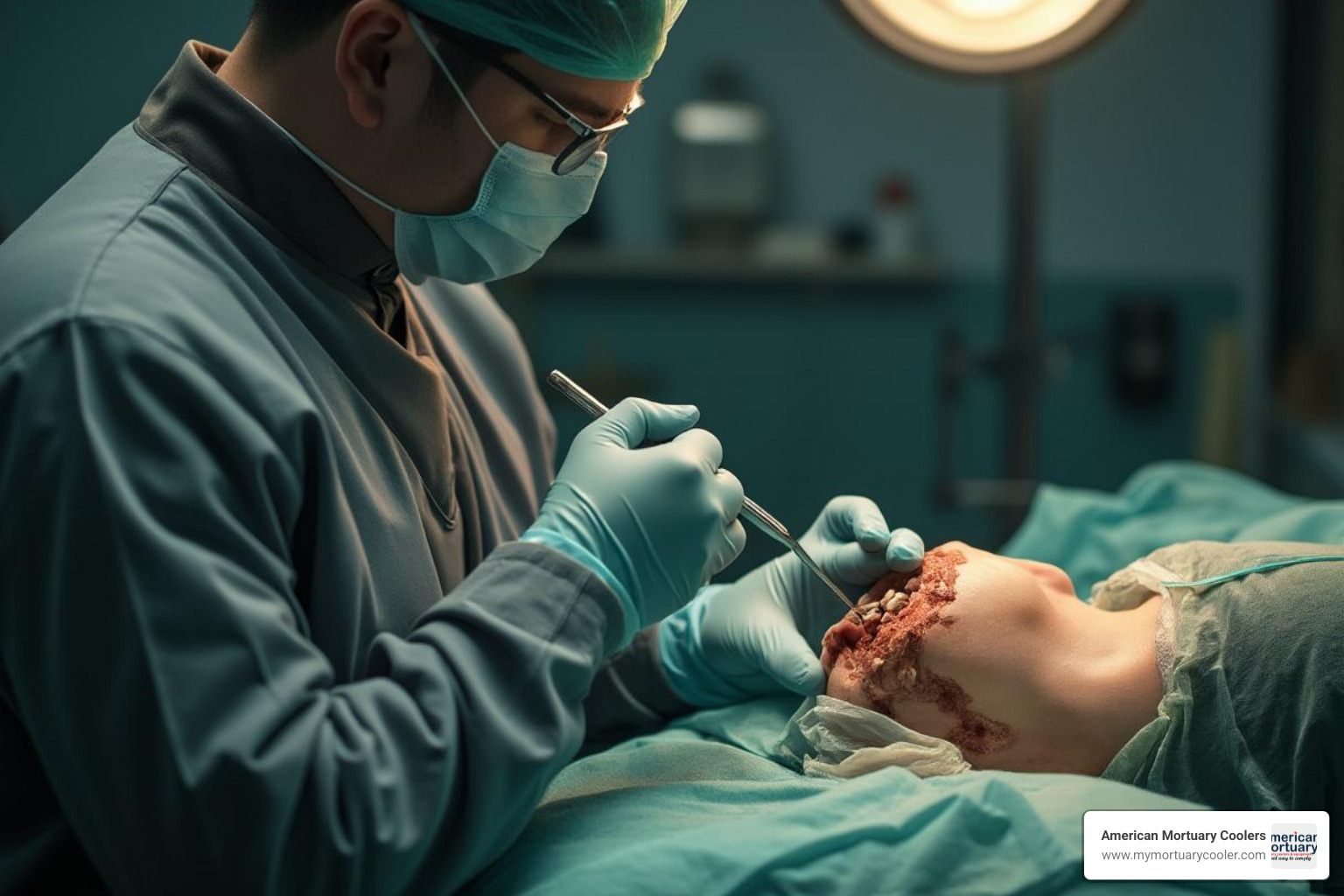
Challenging Physical Conditions
Fractured Jaws and Facial Trauma
When working with accident victims or those who experienced facial trauma, standard closure techniques often won't suffice. In these cases, we typically need multiple wires or sutures rather than relying on a single needle injector. Sometimes, reconstruction must happen before we even attempt closure, occasionally using splints or dowels to provide structural support.
Decomposition Challenges
When advanced decomposition is present, we must first treat and stabilize tissues before attempting any closure. Special preservative compounds are gently injected into the lips and surrounding tissues to restore some firmness. In these situations, more aggressive suturing techniques become necessary.
Autopsy Cases
When working with cases where the head has been autopsied, additional support is crucial. We often place splints or dowels in the spine to properly support the skull. The throat area requires special attention to prevent leakage during viewing.
Edema (Swelling)
Excess fluid retention creates unique challenges for mouth closure. Before attempting to close the mouth, we often need to drain accumulated fluids. Specialized drainage techniques and compounds help reduce swelling naturally.
Age-Specific Considerations
Pediatric Variations
Working with infant and child cases requires an especially gentle touch and specialized techniques. For infants, we typically rely on adhesives rather than invasive methods. We use smaller specialized tools designed specifically for children.
Elderly Subjects
Our older community members present different challenges. Bone atrophy often makes needle injectors ineffective or potentially damaging. For these cases, musculature sutures that don't rely on bone integrity are preferred. Additional wax or filler materials help address sunken features that commonly occur with advanced age.
Cultural and Religious Considerations
Jewish Tradition
Orthodox Jewish practice generally prohibits invasive embalming procedures out of respect for the body's integrity. When serving these families, we use non-invasive methods like mouth formers or simple cotton packing.
Islamic Tradition
Similar to Jewish tradition, Islamic practices typically avoid invasive procedures. Bodies are generally not embalmed unless required by law for transportation. We respect these wishes by using simple, non-invasive closure methods.
Hindu Tradition
With cremation typically occurring within 24 hours, temporary methods may be sufficient for Hindu families. Cultural preferences are carefully discussed with family members to ensure appropriate preparation.
Ask A Mortician – Closing Mouths Post-Mortem
Frequently Asked Questions about How Does a Mortician Close the Mouth
Why aren't stitches or wires visible during viewing?
One question we hear quite often from families is about the visibility of closure methods. Rest assured, when a professional answers the question of how does a mortician close the mouth, invisibility is a top priority.
All closure materials are carefully hidden from view. Needle injectors and sutures are placed entirely inside the mouth, tucked neatly behind the lips where they remain completely invisible. Wires are threaded through the inner mucosa lining of the mouth—never through the visible outer skin.
The finishing touch comes with the skillful application of cosmetics, which further ensures a completely natural appearance. Even in those touching moments when a young child might reach out to touch their grandparent's face, the mechanisms holding the mouth closed remain completely hidden from view.
Can the closure be adjusted after embalming?
Yes, and in fact, adjustments are often necessary for the most natural results. This flexibility is built into our techniques.
The septal suture method specifically uses a temporary bow technique that allows for easy adjustments after the embalming process is complete. Similarly, injector wires can be carefully untwisted and repositioned if needed. The non-invasive approaches using mouth formers offer the most flexibility, as they can be easily removed and reinserted until the perfect position is achieved.
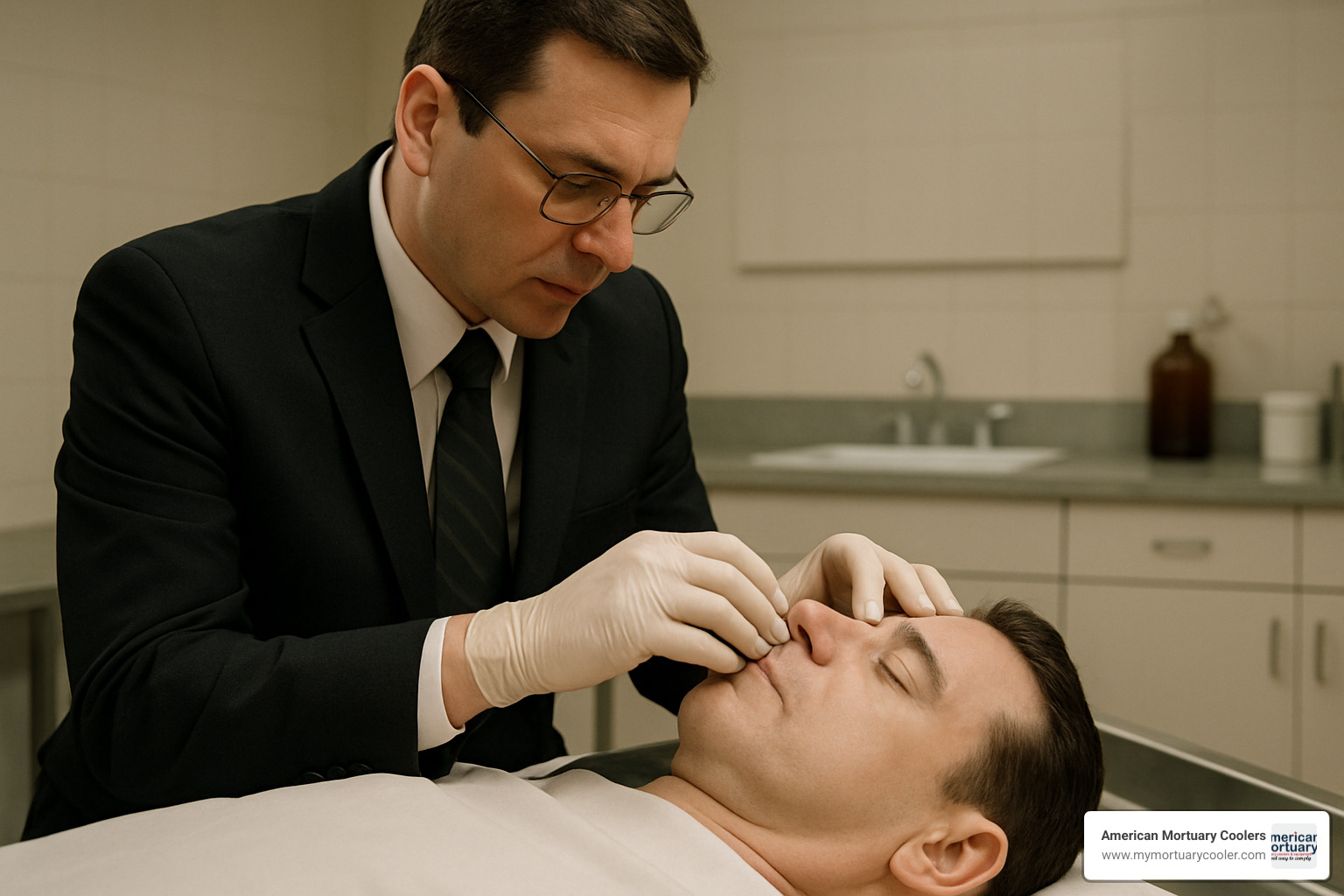
What happens if the deceased wore dentures that are missing?
Missing dentures present a common challenge when addressing how does a mortician close the mouth, but experienced professionals have several effective solutions.
When dentures aren't available, we typically insert clear vinyl mouth formers to create proper shape and support for the lips. These simple devices help maintain the natural contours of the face. We'll often supplement this with carefully placed cotton and specialized wax to recreate the natural fullness of the mouth.

Conclusion
Understanding how does a mortician close the mouth reveals a fascinating blend of technical expertise, anatomical knowledge, and artistic sensitivity that truly defines the embalming profession. Throughout this journey, we've explored the five essential steps that form the foundation of this delicate mortuary practice – each one critical to creating that final peaceful image families will carry with them.
To recap what we've learned:
We need to understand the "why" behind mouth closure. It's one of the very first preparation steps, creating that peaceful appearance while also serving the practical purpose of preventing fluid leakage during embalming.
Proper oral cavity preparation sets the stage for successful closure. The disinfection, aspiration, and throat packing create the foundation for all subsequent work.
Selecting the right technique is where experience truly shines. Whether using needle injectors for standard cases, sutures for more challenging situations, or non-invasive methods for cultural reasons, matching the approach to each unique case makes all the difference.
The finishing touches transform a merely closed mouth into a natural, peaceful expression. This artistry – the careful lip alignment, contouring, and moisturizing – is what families notice.
Being prepared for special challenges sets true professionals apart. Adapting techniques for trauma cases, decomposition, cultural requirements, or age-specific needs requires both knowledge and compassion.
Here at American Mortuary Coolers, based in Tennessee, we've spent years designing equipment that supports these essential procedures. Our custom mortuary coolers and preparation room solutions provide the reliable foundation for dignified, professional care. We're proud to serve funeral professionals across the contiguous 48 states with durable, custom equipment built specifically for these delicate tasks.


















